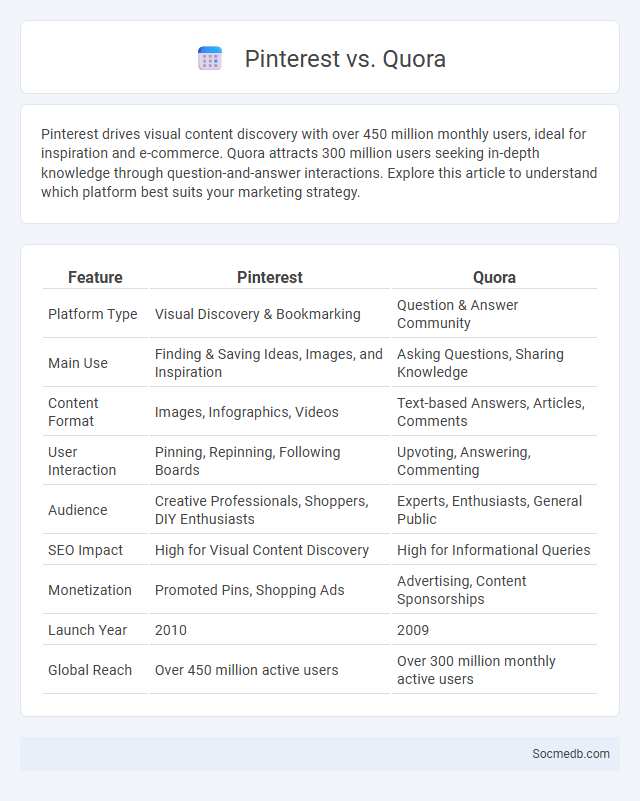
Photo illustration: Pinterest vs Quora
Pinterest drives visual content discovery with over 450 million monthly users, ideal for inspiration and e-commerce. Quora attracts 300 million users seeking in-depth knowledge through question-and-answer interactions. Explore this article to understand which platform best suits your marketing strategy.
Table of Comparison
| Feature | Quora | |
|---|---|---|
| Platform Type | Visual Discovery & Bookmarking | Question & Answer Community |
| Main Use | Finding & Saving Ideas, Images, and Inspiration | Asking Questions, Sharing Knowledge |
| Content Format | Images, Infographics, Videos | Text-based Answers, Articles, Comments |
| User Interaction | Pinning, Repinning, Following Boards | Upvoting, Answering, Commenting |
| Audience | Creative Professionals, Shoppers, DIY Enthusiasts | Experts, Enthusiasts, General Public |
| SEO Impact | High for Visual Content Discovery | High for Informational Queries |
| Monetization | Promoted Pins, Shopping Ads | Advertising, Content Sponsorships |
| Launch Year | 2010 | 2009 |
| Global Reach | Over 450 million active users | Over 300 million monthly active users |
Introduction: Comparing Pinterest, Quora, and Traffic Sources
Pinterest excels as a visual discovery platform driving high-quality referral traffic through image-based content, while Quora leverages question-and-answer interactions to generate targeted leads and enhance brand authority. Understanding the unique traffic sources and user intent on each platform can optimize your social media marketing strategy for better engagement and conversion rates. By analyzing Pinterest's emphasis on inspiration and Quora's focus on problem-solving, you maximize your content's relevance and reach.
Audience Demographics: Pinterest vs Quora
Pinterest's audience predominantly consists of women aged 25-54, with a strong interest in lifestyle, fashion, and DIY content, making it ideal for brands targeting middle-income, creative consumers. Quora attracts a diverse, highly educated audience, skewing more towards males aged 25-44, who seek expert advice and in-depth knowledge across various professional and technical fields. Understanding these demographic distinctions helps marketers tailor content strategies to Pinterest's visually-driven engagement and Quora's information-rich Q&A environment.
Content Formats: Visuals vs Textual Engagement
Visual content on social media platforms, including images, infographics, and videos, generates significantly higher engagement rates compared to textual posts, as users are more likely to interact with visually appealing materials. Platforms like Instagram and TikTok prioritize visual formats, resulting in increased user retention and content sharing, whereas Twitter and LinkedIn leverage text-based content for information dissemination and professional networking. Analyzing engagement metrics reveals that combining concise textual captions with compelling visuals maximizes reach and encourages user interaction across diverse social media audiences.
Traffic Generation Potential: Which Platform Wins?
Instagram's visual appeal drives high user engagement, making it ideal for attracting traffic through compelling images and stories. Facebook offers extensive targeting options and a broad user base, enhancing precise traffic generation for diverse audiences. Your choice depends on industry specifics, but Instagram often excels in organic reach while Facebook dominates in paid traffic campaigns.
SEO Benefits: Pinterest and Quora Impact
Pinterest's visual content boosts your SEO by driving targeted traffic through keyword-rich pins that enhance discoverability on search engines. Quora contributes to SEO by generating high-quality backlinks and increasing domain authority through expert answers that include relevant keywords. Leveraging both platforms strategically can amplify your content's online visibility and improve your website's ranking.
User Intent: Discovery vs Problem-Solving
Users engage with social media platforms primarily for two distinct intents: discovery and problem-solving. Discovery-driven users seek inspiration, trends, and new content, often exploring hashtags, influencers, and viral videos to satisfy curiosity and entertainment. In contrast, problem-solving users leverage social media to find specific information, solutions, or recommendations, utilizing search functions, expert pages, and community forums to address their immediate needs effectively.
Monetization Opportunities: Pinterest vs Quora
Pinterest offers robust monetization opportunities through affiliate marketing, sponsored pins, and product tagging, making it ideal for creators and businesses targeting visual discovery audiences. Quora enables revenue generation via its Partner Program, where users earn money by asking engaging questions that drive traffic, as well as through Quora Ads for targeted advertising to niche communities. Understanding your audience's platform preferences maximizes your potential income by leveraging Pinterest's visual commerce strengths and Quora's knowledge-driven engagement.
Viral Potential: Content Spread and Reach
Viral potential on social media is driven by content that resonates emotionally and encourages sharing, exponentially increasing your reach across platforms. Algorithms prioritize highly engaged posts, amplifying visibility and creating opportunities for rapid content spread to diverse audiences. Optimizing your content with relevant keywords, trending topics, and shareable formats maximizes the likelihood of viral success and sustained engagement.
Best Practices for Driving Traffic from Each Platform
Leveraging platform-specific features such as Instagram Stories, LinkedIn articles, and Twitter threads enhances user engagement and drives targeted traffic effectively. Crafting compelling calls-to-action paired with optimized posting times increases click-through rates across Facebook, Pinterest, and TikTok. Consistent content analysis using analytics tools helps refine strategies, boosting referral traffic and conversion rates from each social media channel.
Conclusion: Choosing the Right Platform for Your Goals
Selecting the optimal social media platform depends on aligning its user demographics, content formats, and engagement features with your specific marketing objectives. Platforms like Instagram and TikTok excel in visual storytelling for brand awareness, while LinkedIn targets professional networking and B2B lead generation. Evaluating metrics such as audience reach, interaction rates, and ad capabilities ensures strategic platform investment that maximizes ROI.
 socmedb.com
socmedb.com